After all not to create only, or found only,
But to bring perhaps from afar what is already founded,
To give it our own identity, average, limitless, free,
To fill the: gross the torpid bulk with vital religious fire,
Not to repel or destroy so much as accept, fuse, rehabilitate,
To obey as well as command, to follow more than to lead,
These also are the lessons of our New World;
While how little the New after all, how much the Old, Old World!… ( Walt Whitman, Song of the Exposition, 1871)
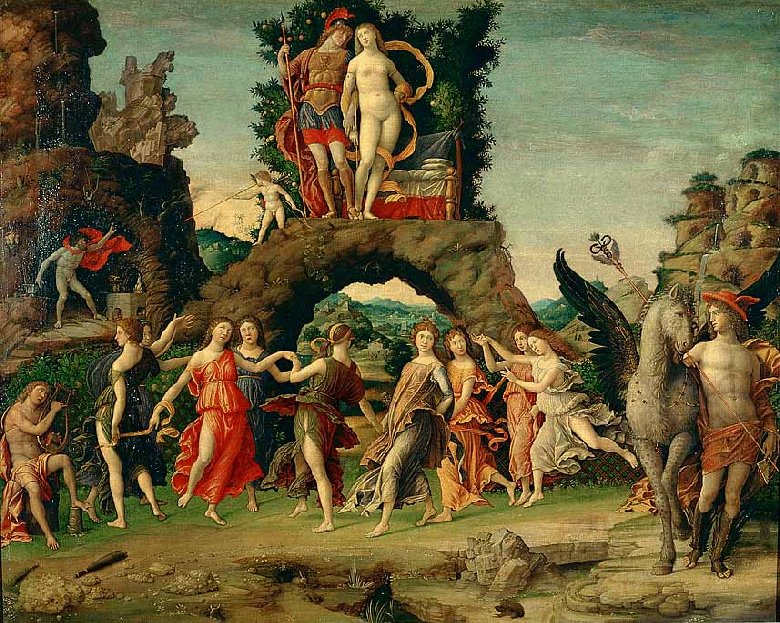
Mantegna.Parnassus.Gombrich:The significance in the comedy of Mars, and Venus trapped by Vulcan for the amusement of the gods may have its origins in the allegorization of Homer attributed in the Renaissance to the philosopher Heroclides Ponticus but now recognized as Heraclitus, an unknown rhetorician of the first century A.D. This text easily accessible to Isabella d'Este's advisors could have furnished the subject matter for Mantegna's Parnassus.
In Andrea Mantegna’s ( 1431-1506) two most puzzling paintings, where, instead of re-creating a spectacle as it could have existed, he enters the field of lyrical allegory as a favor to a lady, Isabella d’Este….
Poor Isabella She was a woman of considerable beauty and intellectual cultivation, but her misadventures with her “studio” in the Gonzafa palace left her forever tainted with a bit of the flavor of a pretentious little bluestocking. At the age of sixteen she married Francesco Gonzaga and as the new great lady of a small court she took over its cultural direction a little prematurely. Her studio, in competition with a similar project of her brother, Alfonso d’Este, grew into a combination of salon, retreat, art gallery, and flattering background intended as an apotheosis of the humanistic spirit.
Isabella planned that the walls should be lined with a set of appropriate paintings by leading artists, and set about with youthful highhandedness to dictate to them. The great Bellini of Venice dryly let her know that he regarded himself as more experienced and competent than she, but Mantegna, as the Gonzaga’s court artist, was more indulgent. Meeting her at least halfway, he completed two paintings-“Minerva Expelling the Vices from the Grove of Virtue” and “Parnassus”, both now in the Louvre- along with such other paintings as were completed for the studio.
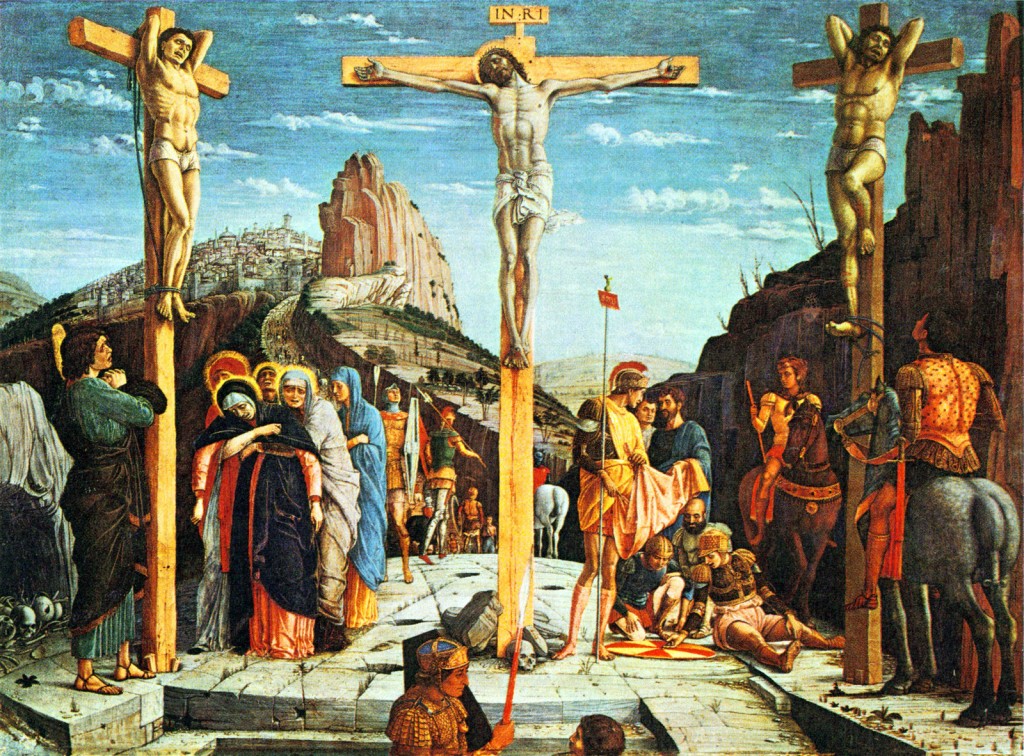
The majestic Crucifixion, serene but intense, is one of three panels painted for the predella, or base, of an altarpiece in the church of San Zeno, Verona. The violence beneath its reserve is evident in certain details such as the soldiers casting lots for Jesus' robe. The altarpiece was carried off to France by Napoleon in 1797, and returned in 1815 minus the best part of it- the predella panels.
…Long and long has the grass been growing,
Long and long has the rain been falling,
Long has the globe been rolling round.
Come Muse migrate from Greece and Ionia,
Cross out please those immensely overpaid accounts,
That matter, of Troy and Achilles’ wrath, and Aeneas’, Odysseus’ wanderings,
Placard “Removed” and “To Let” on the rocks of your snowy Parnassus,
Repeat at Jerusalem, place the notice high on Jaffa’s gate and on Mount Moriah,
The same on the walls of your German, French and Spanish castles, and Italian collections,
For know a better, fresher, busier sphere, a wide, untried domain awaits, demands you.” ( Whitman )
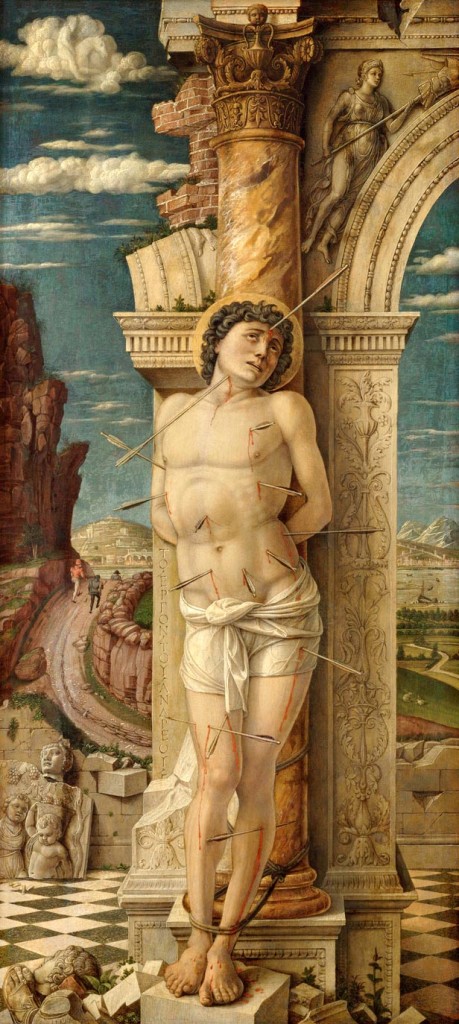
Although Jesus's Crucifixion certainly holds more importance to the new testament than the suffering of Saint Sebastian, it is the latter whose portrayal appears to be the more sexualized of the two. In his discussion of Saint Sebatian's portra
in art, Edward Lucie-Smith associates the arrows piercing of the saint with the phallus.“Curiously enough . . . it is representations of male saints which offer more abundant material for the study of sadistic imagery in painting than representations of female ones. St Sebastian, for example, is one of the most frequently represented personages in Christian art, and the scene chosen is most usually that in which we see him bound and pierced with arrows (the role played
by the arrow as one of the most candid of phallic symbols . . .” ( Lucie-Smith )
Nobody, it appears, will ever know exactly who made what concessions to whom, or precisely what Mantegna had in mind with the so-called “Parnassus”. There have been suggestions that Mantegna, now in his sixties, might have been very gently pulling his young patroness’s leg- a thoroughly unlikely possibility since contemporary accounts reveal him as a severe and even acerbic personality.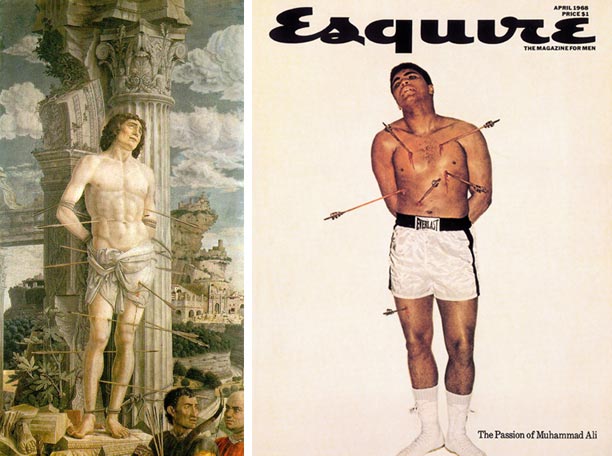
Such a personality was not perfectly adaptable to the requirements of ornamenting a salon in an appropriately feminine character, but Mantegna sufficiently modified his manner to create a pair of pictures where sensuous opulence , ornamental elegance, and his own unrelenting formal disciplines are combined into somewhat uneasy emulsion. “Minerva Expelling the Vices” presents no great problems of interpretation since its content is entirely expected from the explanatory title, and any figures that might offer problems are conveniently labeled; the final effect of fantasy is strong enough to hold its own against the rather elementary didactic allegory.

Louvre:She entrusted Mantegna with the first two canvases of the cycle, Parnassus (1497) and Minerva (1502), but considering his work out-of-date, she turned to the most famous painters of the new generation. In vain she solicited Giovanni Bellini, Leonardo da Vinci and Francesco Francia but, in 1505, she obtained only the disappointing painting by Perugino. Lorenzo Costa, appointed court painter at Mantegna’s death (1506), completed the decoration with two canvases delivered between 1506 and 1511. The Parnassus and Minerva were painted by Mantegna to be placed opposite each other, as demonstrated by the fact that the light comes from the left in the first painting and from the right in the second.
But “Parnassus” bears no labels, and while there is not much question as to the identities of the Olympian figures involved, just hat they are doing, and in what spirit they are doing it, is less certain. Apollo, just possibly Orpheus, is seated at the far left. The Muses dance in the center. Mercury, with a tamed and most wonderfully bizarre Pegasus, is at the far right, while mars and Venus surmount the composition. Vulcan, Venus’s blacksmith husband, is in a cave with his forge at the left, and is the object of attention by a cupid who blows in his direction through a long trumpet.
All of this, even more than its companion painting, suggests a stage and a pageant. In all probability it resembles the sets, gone without record, that Mantegna as part of his duties designed for the elaborate performances that were staged at court.But what goes on? Is the illicit love of Mars and Venus being celebrated here in an ennobled way, or is the whole thing, as some scholars believe, an exercise in the mock-heroic? Is there a half-humorous reason for making Mars an almost lisssome matinee-idol type, a youthful philanderer, instead of showing him in his more conventional aspect as a mature, heavily muscled, hypermasculine man? Is the long horn blown by the cupid a “horn of fame” , a type so used elsewhere, and is the fame thus visited upon Vulcan his unwelcome notoriety as cuckold? Above all, the two Muses at far right and, less noticeably, the two at far left have joined thumbs and fingers in a gesture still used in Italy as a bawdy reference to sexual union.
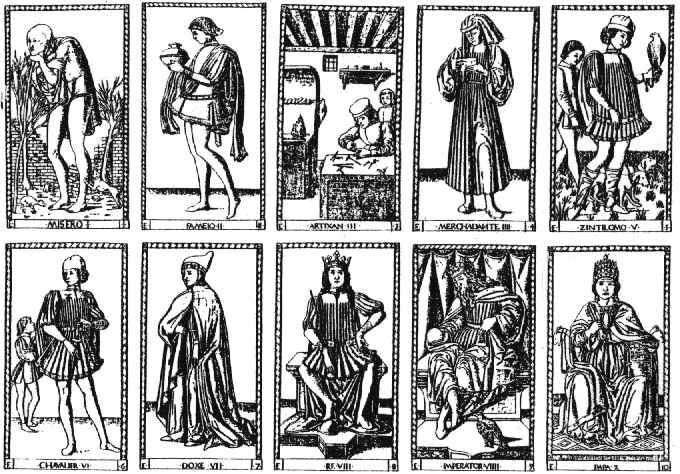
McLean:The symbolism of these cards, or perhaps we should say 'emblematic figures', would seem to derive from the Hermetic tradition which is now recognised as underlying the Italian Renaissance of the mid-fifteenth century. It was during this period that the Platonic Academies of the Medici's were set up and Ficino and other scholars began translating texts such as the Corpus Hermeticum and the works of Plato, some of which were brought to the Court of Florence from Constantinople by Gemistus Plethon (c.1355-1450), a Greek scholar who was probably an initiate of a 'Platonic' Mystery School in the East. This reconstruction of hermetic and neoplatonic esotericism is reflected in such ideas as the Muses, the Liberal Arts, the Cardinal Virtues, and the Heavenly Spheres, and it is my view that the Tarocchi of Mantegna should be seen as an 'emblem book' of this hermetic current. The fact that its designs show parallels with the later tarot decks should therefore be of the greatest interest both to students of tarot and of Hermeticism.
ADDENDUM:
( Naumer ):We know that the setting of the Parnassus is a garden, because the area in which the Muses dance is partially enclosed
by lattice-work fencing. The fence, visible in the middle ground on the right and on the left, serves to identify this area as garden space. Mantegna probably intended this fence to be even more prominent, but the part of it that encircled the grove of the Muses was partially painted over with pale green paint during a restoration. On the far left in the middle ground an angry Vulcan shakes his hand at the cuckolding couple of Mars and Venus. Vulcan’s cave has some features of a grotto. A fantastic crystalline rock formation crowns it, but what appears to be a natural waterfall springing from the left side of the cave mouth is a bundle of long pieces of silver wire. The splashing droplets of water at Vulcan’s feet are in fact sweat dripping fromVulcan’s overheated chest.
The wire refers to the nets made by Vulcan to capture Mars and Venus, and their depiction here involves Mantegna’s response to a passage in AngeloDecembrio’s De polita litteraria, a monologue on art spoken by Leonello d’Este and responded to by members of his court. Claiming that painters can never match the literary descriptions of poets in their images, it particularly referred to Ovid’s
description of the fine nets created by Vulcan. Mantegna used his skill to insist that the painter can match the poet’s ability
in depicting extraordinarily fine details. Mercury and Pegasus stand together on the far right where a pool springs from the feet of Pegasus.
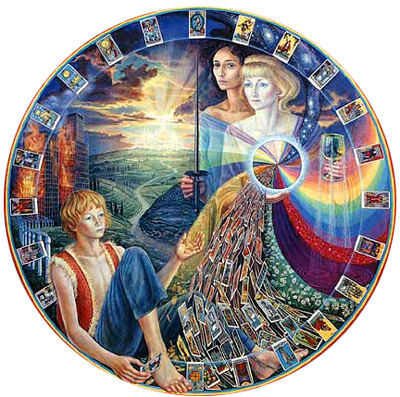
Philip Coppens:As mentioned, when tracing the origins of playing cards, we know they came into Europe from Moorish Spain. But in Spain, they had arrived from Egypt. These were, however, traditional playing cards. As researcher Stephen J Ash points out: “it is unknown where the 22 picture cards came from.” It is possible that the Italian Tarocchi games – from which the name tarot is believed to have been derived from – were the first to combine the traditional playing cards with the 22 “tarot” cards. What is clear, is that by 1470 – the Renaissance – the Mantegna Tarrochi had five suites of ten cards, based on the planets, muses, arts, ranks and cosmic principles, thus clearly showing their occult – in this case, Kabbalistic – dimension. So where does this leave the debate? It is clear that the tarot has an occult dimension, and that this occurred relatively recently, during the Renaissance. This mixture of Hermetica and Kabbalah by default has overtones with the Grail, because, as argued in “Servants of the Grail”, the medieval story of the Grail was a westernised rendition of the Hermetic Quest.
These two figures illustrate the profound influence on Mantegna’s artistic development of the sculpture displayed in the courtyard gardens and vigne of Rome. The figure of Mercury was based on the statue of this god in the della Valle collection, and he based the Venus in this painting on that depicted on the della Valle Judgement of Paris sarcophagus.We know Mantegna saw this collection when he was in Rome, because of a number of his drawings based on statues within the collection. In addition, the courtyard of his new house in Mantua, built after he returned from Rome, was very similar to the della Valle’s palace courtyard.These figures, as clear references to sculpture displayed in Roman courtyard gardens, serve to reinforce the garden theme.
The garden theme is advanced by the inclusion of fences and cultivated plants, clearly features belonging to gardens,
not elements of untamed nature. In some cases, though, the grotto is intended to evoke the wild, potentially frightening aspect of the natural world. The hills above the figure of Mercury are dotted with caves which were the inspiration for the grotto in the Renaissance garden. Both the spring and the grotto had connections to the Muses through ancient myth,
and they were important garden features in the Renaissance. This painting combined classical antiquity, with specific garden
references holding special significance for Isabella d’Este, her family and her intellectual circle, and it embodied
Mantegna’s response to Leonello d’Este’s artistic challenge.






 COMMENTS
COMMENTS